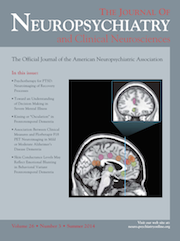To the Editor: Autoimmune encephalitis is a heterogeneous group of disorders characterized by cognitive and behavioral decline due to an immune reaction against neuronal antigens. They include both disorders characterized by autoantibodies against intracellular antigens (paraneoplastic and non-paraneoplastic variants) as well as neuronal surface antigens [voltage-gated potassium channel (VGKC),
N-methyl-D-aspartic acid (NMDA), AMPA receptors, etc.]. Psychiatric manifestations of autoimmune encephalitis have not been adequately discussed in the literature in spite of a high prevalence of the same.
1 Voltage-gated potassium channel (VGKC) antibody-associated encephalopathy, a rare cause of limbic encephalopathy, has been described to typically present with memory impairment and seizures.
3 I report on an elderly male with VGKC encephalitis with prominent psychiatric symptoms along with neurological symptoms resulting in a diagnostic dilemma.
“Mr. J,” a 61-year old married male, presented to the psychiatry outpatient department of our tertiary care hospital with a 4 month history of significant behavioral changes including irritability, anger outbursts, irrelevant talking, and visual and auditory hallucinations accompanied by hallucinatory behaviors and persecutory ideas; multiple seizure episodes characterized by loss of consciousness, dystonic posturing, tongue bite, fixed gaze, and gestural automatisms along with impairment of memory/cognition characterized by increasing forgetfulness as well as dressing apraxia. There was neither a history of cranial nerve involvement, other involuntary movements, autonomic dysfunction nor a past history of psychosis, mania, depression, or anxiety disorder. There was no history of substance use or family history of psychiatric, movement, or neurological disorder.
The patient was referred to and assessed by a neurologist and was started on valproate (600 mg/day). There was no decrease in the frequency of seizures and the behavioral symptoms worsened. An MRI revealed subtle hyperintense signal intensities in the bilateral medial temporal lobe and insular cortex. An EEG did not reveal any abnormalities. The patient was hospitalized for further assessment. A bidaily Mini-Mental State Examination (MMSE) was performed and was usually in the range of 15–18/30. The Brief Psychiatric Rating Scale (BPRS)
2 score was 45 at the time of admission. Considering the profile of symptoms, the rapid progression, and MRI findings, the differential diagnosis included chronic herpes encephalitis, prion diseases like Creutzfeldt-Jakob disease, a rapidly progressive variant of frontotemporal dementia, and autoimmune encephalitis (including VGKC/ NMDA receptor encephalitis). Meanwhile, a psychiatry consultation was taken. The possibility of organic psychosis was entertained and T.quetiapine was started at 50 mg/day and increased to 150 mg/day in a week. A battery of investigations were performed including routine hemogram, hepatic, renal function tests, CSF analysis, serum B
12, folate, thyroid function tests, hepatitis, HIV antigens, as well as a complete autoimmune panel consisting of radiofrequency, antineutrophil cytoplasmic antibody, antinuclear, anti-NMDA, and anti-VGKC antibodies. To rule out paraneoplastic manifestations of tumor, an [
18F]fluorodeoxyglucose positron emission tomography CT was also performed that revealed no occult malignancy. The remaining investigations were also normal except anti-VGKC antibodies that turned out to be positive with a titer of 445 pmol/L (normal range: 0–100 pmol/L). A course of 5 days of injectable steroid was initiated along with intravenous immunoglobulin for the same period as an immunomodulator. The patient showed a rapid response to treatment with improvement in both cognitive and behavioral symptoms. There were no further seizure episodes. The patient’s MMSE returned to the range of 28–30/30 within 4 days of initiating therapy. A titer of VGKC autoantibodies also dropped drastically following immunomodulatory therapy. Valproate and quetiapine was gradually tapered over the next week and the patient was shifted to oral prednisolone (60 mg/day) prior to discharge. The BPRS score dropped to 12 at the time of discharge.
This case highlights the diverse cognitive and behavioral symptoms in these disorders and the need for psychiatrists to consider the entity of autoimmune encephalitis in their differential diagnosis for patients with atypical behavioral changes. Moreover, considering the distinct possibility of such patients presenting initially to a psychiatrist and the possibility of complete cure with immunomodulatory therapy, psychiatrists should have a good understanding of the clinical presentation, appropriate investigations, and unique treatment interventions of this condition.

